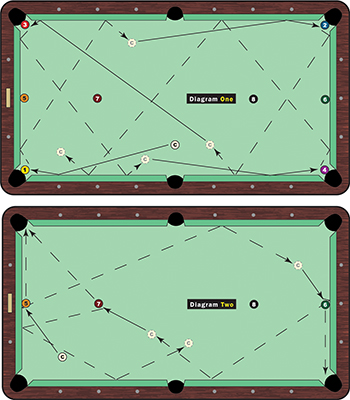A clever drill to move from “hangers” to the next shot.
Many drills are geared to the development of cue ball control. Being able to master your cue ball, control speed and develop good patterns comes from challenging yourself with drills like the one I’ve devised here. This is a clever little drill that will frustrate most amateurs and challenge higher-level players, but it is a great way to improve your overall game.
At first glance, this drill looks easy. It is a rotation 8-ball drill and the first four balls are hanging in corner pockets. Here’s the catch: The four corner balls (1-4) must be played rail first, and after contacting the object ball, the cue ball must hit a minimum of two rails. Additionally, the cue ball can’t contact another object ball during the drill. Shots like the 4 ball, in which you have to get the cue ball back up table for the 5 ball, come up all the time in matches.
Players are often perplexed at how to approach the shot. Amateurs, particularly, will play the cue ball directly into the object ball. Often times they hit it too thin and don’t get the second rail, or they scratch into the side pocket. That approach makes it harder to control the speed and angle.
The main reason you use rail first is to widen the angle, which is the safest way to avoid a scratch. It is also the easiest way to stay in line for the next shot.
Judging the exact contact point on the first rail is huge, as is judging the speed of the shot. Measuring these shots is the same as the mirror image approach I’ve discussed. With the balls so close to the pocket, it should be easy to judge the entry angle to the object ball. Ideally, you would like to have half-ball contact on each side of the ball, and no less than quarter-ball contact. You may fail a few times at the start, but you will figure it out pretty quickly. You will also realize that, even though this shot is virtually impossible to miss, it needs to be practiced and not taken for granted.
I always play the rail-first shots with a touch of running (outside) English. On the 1 ball (Diagram One), that would be a touch of right, high on the cue ball. Same with the shot on the 2 ball. The 3 and 4 would require high left. This helps the cue ball gather speed and slide better off the second rail for a nice natural path to the next shot.
Shots 5-8 do not have to be shot rail first, but do require that the cue ball contact two rails for position on the next shot. This comes down to personal preference. Obviously, a lot depends on the angle. With the angle I ended up with after pocketing the 4, I would take the two-rail path shown in Diagram Two, using a touch of right. If the angle on the 5 was smaller, I would probably go three rails with a lot of right English. It would allow me to let my stroke out and it takes away any possible scratch.
The approach to the shots that follow are also shown in the diagram. A little left on my shot at the 6 would eliminate the scratch in the side pocket. Finally, I would use a punch shot with a touch of right English on the 8 to send the cue ball safely two rails. That is always the way forward on game ball.
I really like this drill. Every shot requires some imagination and feel.






